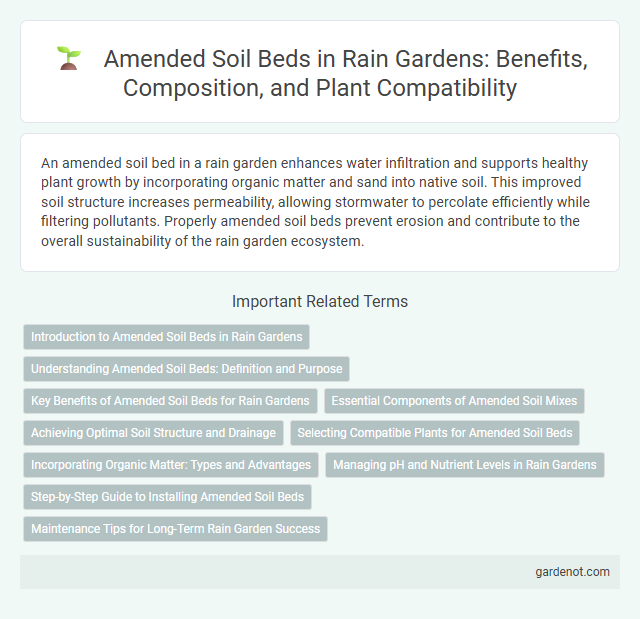An amended soil bed in a rain garden enhances water infiltration and supports healthy plant growth by incorporating organic matter and sand into native soil. This improved soil structure increases permeability, allowing stormwater to percolate efficiently while filtering pollutants. Properly amended soil beds prevent erosion and contribute to the overall sustainability of the rain garden ecosystem.
Introduction to Amended Soil Beds in Rain Gardens
Amended soil beds in rain gardens enhance infiltration and support healthy plant growth by improving soil structure and nutrient content. These beds typically combine native soil with organic matter such as compost to increase porosity and water retention capacity. Properly designed amended soils prevent runoff, reduce erosion, and promote pollutant filtration in urban stormwater management systems.
Understanding Amended Soil Beds: Definition and Purpose
An amended soil bed is a specially prepared planting area enriched with organic matter, sand, or compost to improve soil structure, drainage, and nutrient content. This enhancement promotes the growth and health of plants in rain gardens by facilitating better water infiltration and retention. Understanding the composition and purpose of amended soil beds is essential for optimizing rain garden performance and supporting sustainable stormwater management.
Key Benefits of Amended Soil Beds for Rain Gardens
Amended soil beds enhance rain garden performance by improving soil permeability and nutrient retention, enabling efficient stormwater infiltration and reducing runoff. The addition of organic matter and sand increases soil aeration and supports healthy root development, promoting robust plant growth. These improvements contribute to pollutant filtration, groundwater recharge, and overall ecosystem health in urban stormwater management.
Essential Components of Amended Soil Mixes
Amended soil beds for rain gardens require a balanced blend of sand, compost, and topsoil to enhance permeability and nutrient retention. Essential components include 60% sand for drainage, 30% compost to improve organic content, and 10% native topsoil to support microbial activity crucial for plant health. Proper texture and organic matter levels prevent waterlogging while promoting pollutant filtration and root growth.
Achieving Optimal Soil Structure and Drainage
Amended soil beds in rain gardens enhance water infiltration and nutrient retention by combining native soil with organic matter such as compost and sand, achieving optimal soil structure and drainage. This engineered soil mixture prevents surface runoff, reduces erosion, and supports healthy plant growth by balancing permeability and moisture retention. Properly amended soil beds facilitate the efficient absorption of stormwater while filtering pollutants, contributing to sustainable urban water management.
Selecting Compatible Plants for Amended Soil Beds
Selecting compatible plants for amended soil beds in rain gardens ensures optimal water absorption and nutrient uptake. Native plants such as Carex spp., Juncus effusus, and Asclepias incarnata thrive in amended soils due to their adaptability to varying moisture levels and enhanced soil structure. Incorporating species with deep root systems improves soil permeability and supports the rain garden's stormwater management goals.
Incorporating Organic Matter: Types and Advantages
Incorporating organic matter such as compost, shredded leaves, and aged manure into the amended soil bed significantly enhances its water retention and nutrient-holding capacity, essential for effective rain garden performance. These organic materials improve soil structure by increasing porosity, which promotes better infiltration and supports beneficial microbial activity crucial for pollutant breakdown. The enhanced soil fertility and moisture regulation resulting from organic matter incorporation contribute to healthier plant growth and increased resilience during dry periods.
Managing pH and Nutrient Levels in Rain Gardens
Amended soil beds in rain gardens enhance water filtration and support plant health by optimizing pH and nutrient levels. Incorporating organic matter such as compost adjusts soil acidity, promoting nutrient availability and microbial activity essential for pollutant breakdown. Regular soil testing guides amendments with lime or sulfur and tailored fertilizer applications to maintain balanced nitrogen, phosphorus, and potassium levels conducive to diverse native plant growth.
Step-by-Step Guide to Installing Amended Soil Beds
Begin installing an amended soil bed by excavating the rain garden area to a depth of 12 to 18 inches, ensuring proper sloping for water infiltration. Mix native soil with organic compost and sand in a 50:30:20 ratio to enhance drainage and nutrient retention. Compact the mixture lightly before planting to create a stable, well-draining base for runoff absorption and healthy vegetation growth.
Maintenance Tips for Long-Term Rain Garden Success
Amended soil beds in rain gardens require regular monitoring to maintain optimal drainage and nutrient balance, ensuring plant health and pollutant absorption efficiency. Periodic soil testing and incorporation of organic matter help sustain soil structure and microbial activity, crucial for long-term filtration performance. Removing accumulated sediment and controlling invasive species prevent clogging and preserve the garden's water retention capacity over time.
Amended soil bed Infographic

 gardenot.com
gardenot.com